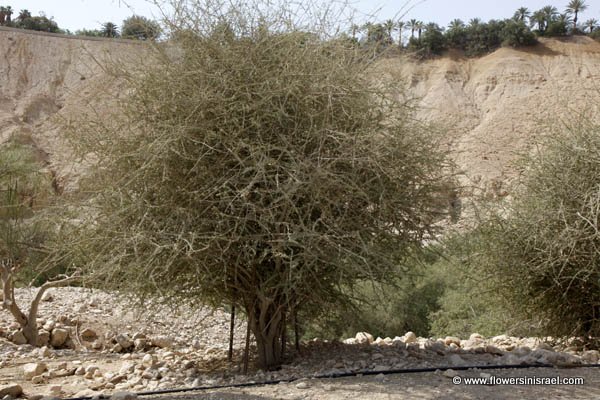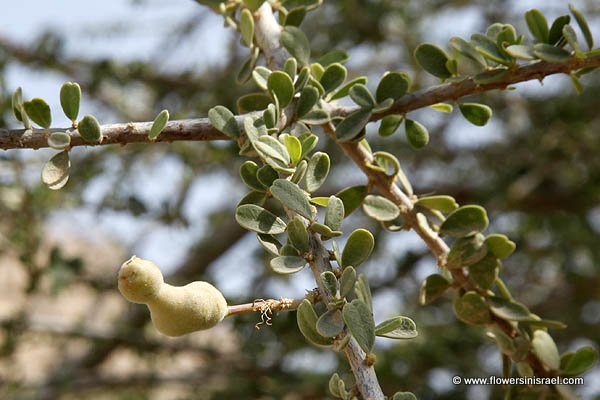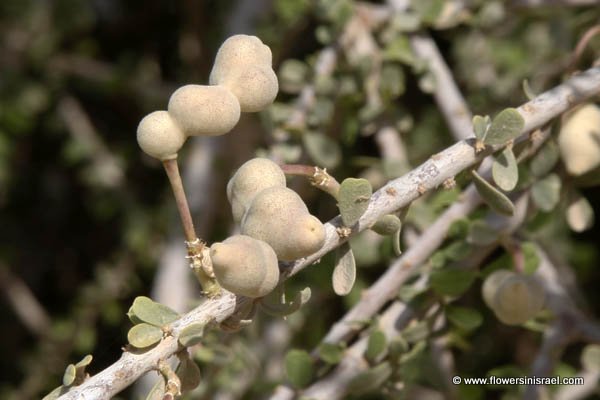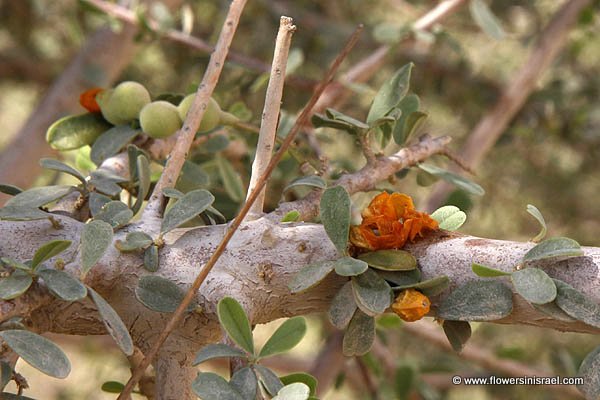Hebrew: מרואה עבת-עלים, Arabic: maeru, meru, sarah, sarh, sarha, sarkh
| Scientific name: | Maerua crassifolia Forssk., | |
| Synonym name: | Maerua rigida R. Br., Maerua hirtella Chiov., Maerua uniflora Vahl | |
| Common name: | - | |
| Hebrew name: | מרואה עבת-עלים | |
| Arabic name: | maeru, meru, sarah, sarh, sarha, sarkh | |
| Family: | Capparaceae, Caper family, צלפיים |

|
| Life form: | Tree, scandent shrub | |
| Stems: | 1-7 m tall, usually with rounded flattish crown; trunk twisted, up to 40 cm diam., drooping; smooth, grey bark, scaly on old trunks, with yellowish slash and green rhytidome; pubescent grey-brown stems | |
| Leaves: | Shortly petiolate, usually clustered on short spur-branches; alternate or fasciculate; Oblong-ovate, leather-like, glaucous, grey-green, finely pubescent or glabrous | |
| Inflorescence: | Solitairy or in groups of 2 or 3 in clusters of leaves | |
| Flowers: | White, sweet-scented; sepals greenish yellow; no petals | |
| Fruits / pods: | Berry, rosary shaped (torulose), up to 2-5 cm long, pubescent, grey to brown | |
| Flowering Period: | December, January, February, March, April, May | |
| Habitat: | Sudanian | |
| Distribution: | Negev Highlands, Dead Sea Valley, Arava Valley | |
| Chorotype: | Sudan | |
| Summer shedding: | Perennating |

Derivation of the botanical name: Maerua has an entry in the 11th century Arabic encyclopedia The Canon of Medicine under the name "meru" and this name became the source for the Latin genus name Maerua; مرو, Maerua crassifolia, Book II - On specific Drugs set down alphabetically, Two Subsections (Materia medica), page 205 crassifolia, crassus, solid, thick; folius, leaf; thick leaved. rigida, rigid, stiff. hirtella, a little hairy. uniflora, one flowered. The Hebrew name: מרואה, maerua, a transliteration from the scientific name.
Some consider the mainly coastal, glabrous plants to be Maerua crassifolia, and the pubescent plants to be a separate, more widespread taxon, which would have to be called Maerua rigida R. Br. The ranges of both of these taxa overlap in southern and western Arabia. The main vegetable species listed in ancient Egyptian texts are the Acacia Nilotica (occurs 28 times equally distributed between Upper and Lower Egypt), Balanites aegyptiaca (22 times), and the Ziziphus spina Christi (23 times). The fourth place takes the Maerua crassifolia, and occurs 7 times and only in Upper Egypt. Maerua crassifolia, the ima tree of the ancient Egyptians, is a shrub or small tree, which has no vernacular name in our languages. Its presence is not often mentioned – seven times – as a sacred tree, but it is rather widely attested in the Egyptian toponymy in the Southern as well as in the Northern area. According to the Egyptians, the oasis of Siwa was considered as the place of the ima trees and Imaou – the name of which indicates the presence of the species Maerua crassifolia – is a town on the fringe of the Western delta. It is worshipped at Edfu along with the Balanite and the Acacia. The tree itself is used to mark the years of the king and is associated with coronation rites; its wood was linked to the transmission of the divine heritage. To memorialise these ideas, the Egyptians offered some leaves of balanite, Maerua crassifolia and Moringa to the divine host of the Edfu temple. 

|